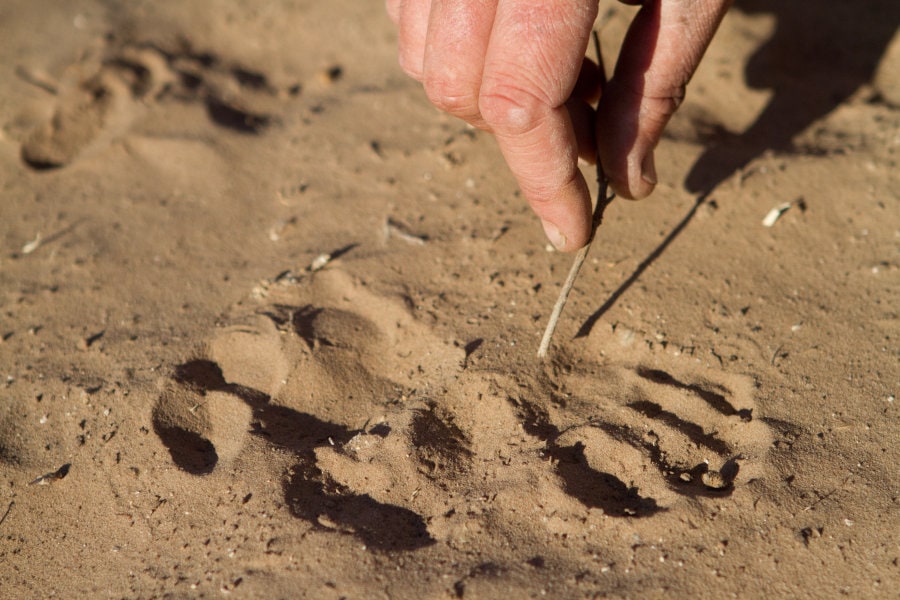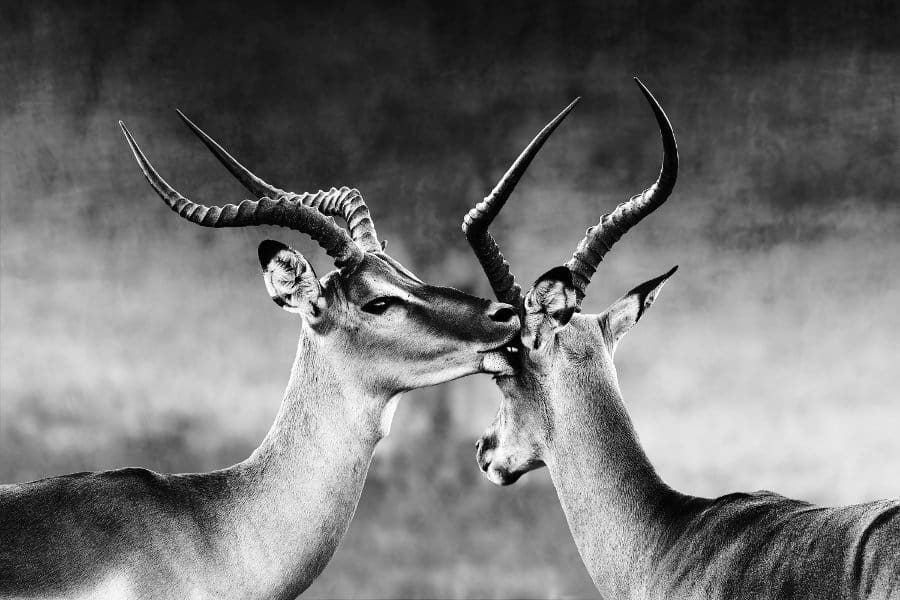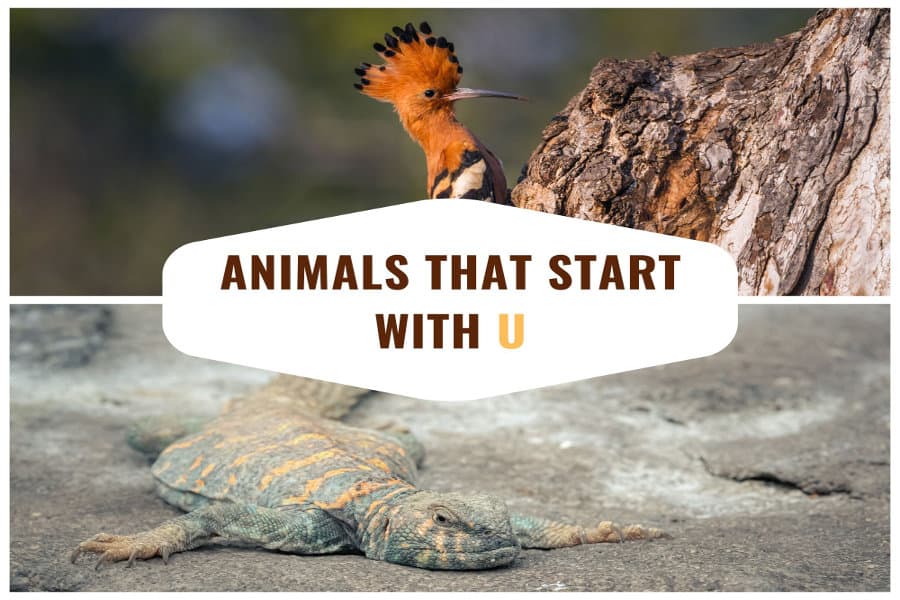Not all animal tracks are as easy to interpret as a warm pile of fresh elephant dung.
Like everything in Africa, tracking wildlife requires visitors to use all their senses to truly experience the unique magic of being at one with nature.
Being able to identify tell-tale spoor of some popular animals while on a safari can mean the difference between a memorable wildlife encounter or not spotting an animal concealed just meters away.
The most rewarding game sightings often begin with noticing almost insignificant-looking signs, tracks, or spoor.
This handy field guide walks you through some signs of mammal spoor to look for while exploring the untamed African landscape.
Get ready to engage all your senses and actively participate while tracking the animals on your safari bucket list. Are you all set? Let’s hit the trail!
What is the Difference Between Animal Tracks and Spoor?
![]()
A good starting point for our expedition is to know what general hints to look out for.
Animal tracks usually refer to clues left on the ground. Tracks in the form of hoof or paw prints often provide a good starting point regarding:
- The species present in the area.
- The approximate size of individual animals.
- The direction the animal was moving.
- The speed at which the animals were moving — Relaxed, browsing animals leave a concentrated series of prints, while one can expect larger gaps between prints if an animal is in a hurry.
- The number of animals in a group.
Signs of the wild while tracking wildlife doesn’t only involve scanning the ground for imprints left in the soil.
Tracking spoor is an intimate activity that requires visitors to observe details from close up, touch, smell, listen carefully, and become one with their untamed surroundings.
Spoor includes taking note of droppings, broken or browsed foliage, blood, scents, and even distinctive sounds that can provide important information.
Spoor and Signs to Help You Track Africa’s Big 5
Sightings of Africa’s Big Five safari animals are a thrilling highlight on any game drive. Despite their reputation of fearlessness, locating them in the vast African wilderness can often prove challenging.
Surprise your safari guide by keeping your eyes peeled and knowing the following signs of the wild and animal tracks to look out for.
1. Lion spoor looks similar to house cat tracks

Despite mainly living in open African savannah areas, lions are often called the ‘king of the jungle’.
Regardless of this auspicious title, this mighty monarch may not want you to know that in many ways, his paw prints are a lot like (really, REALLY) oversized domestic cat paw prints!
Before even arriving on safari in Africa, carefully examine the paw prints your miniature house panther leaves around the house.
You will notice the following:
- There are three lobes on the back pad of the foot. This is distinct from wild dogs or hyenas, which only have two.
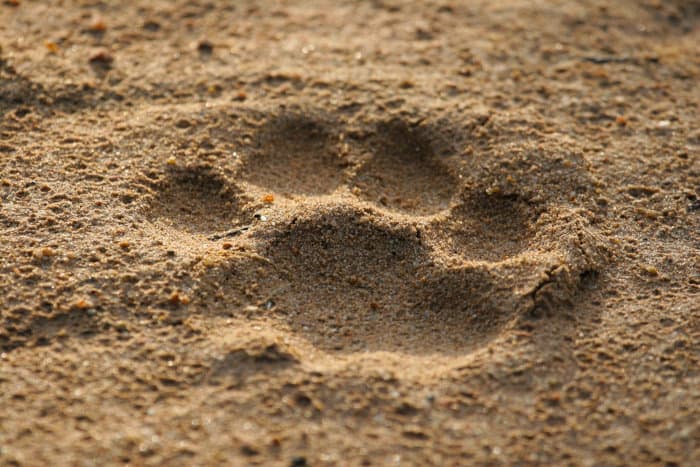
- Most cats, except for cheetahs, have fully retractable claws. Lions’ tracks leave no trace of claw impressions on the ground.
2. Leopard tracks are smaller than lion tracks

Leopards are the undisputed masters of camouflage, making sightings memorable and brag-worthy achievements. In addition, their solitary habits make finding them even more challenging.
Lion and leopard tracks are similar in many respects, except in size. An adult lion can weigh more than double that of a fully grown male leopard, which only reaches a maximum weight of around 80 kg (176 lbs.).
When finding the spoor of a solitary feline with small tracks, it is more than likely a leopard.
Since leopards are highly territorial, spoor to look out for while tracking include:
- Scratches on trees.
- Urine scent marks to mark out their territory.

- Droppings that often include large amounts of hair, hooves, and bone fragments. You may even be able to recognize bits of tooth or quills from prey animals. Leopard feces may be conspicuous as they use their scent to advertise far and wide that the area is occupied.
3. Elephant spoor is about counting toes

Even though elephants are the largest land mammals, did you know that they are always walking on their tippy toes?
These giants of Africa are among the easiest to identify from spoor as their signs are often hard to miss!
Here’s what to look out for:
- Soccer ball-like tracks from their large front feet leave. Their back feet leave oval impressions.
- Tracks that are between 50 and 59 cm (19.6-23.2″).
- Front feet tracks that have five hoofed toes, and hind feet that have four. These can be tricky to see in dry soil tracks.
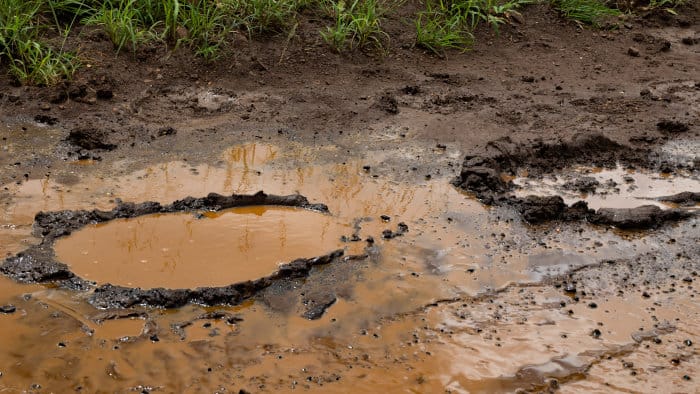
- Look out for signs of damaged or trampled foliage.
- You may spot elephant dung — distinctive large, fiber-rich piles of digested plant matter.
- Listen carefully for sounds like cracking branches, which are tell-tale signs of elephants in the vicinity.
4. African rhinos have designated toilet areas

Can you imagine communicating with poop?
That’s what rhinos do, and these endangered creatures transmit a lot of information regarding their age, sex, and territorial status to other rhinos with their dung odors.
To ensure that everyone gets the messages about who is around, black and white rhinos use communal toilet areas known as middens. These can be up to 65 ft (19 m) across.
When tracking rhino spoor, look out for:
- Distinctive three-toed tracks. It is a unique feature. The middle toe on each foot is the longest, with the two shorter toes on either side.

Since rhinos are much shorter than elephants and far quieter and more graceful eaters, they can be tricky to see and hear.
Some wildlife reserves have fitted tracking devices on individual rhinos. This makes locating them for game-viewing purposes much easier.
While it may be a cheat-street method to locate and tick this species off your viewing list, this modern technology certainly is a win for conservation efforts.
5. Cape buffalo tracks are similar to domestic cattle
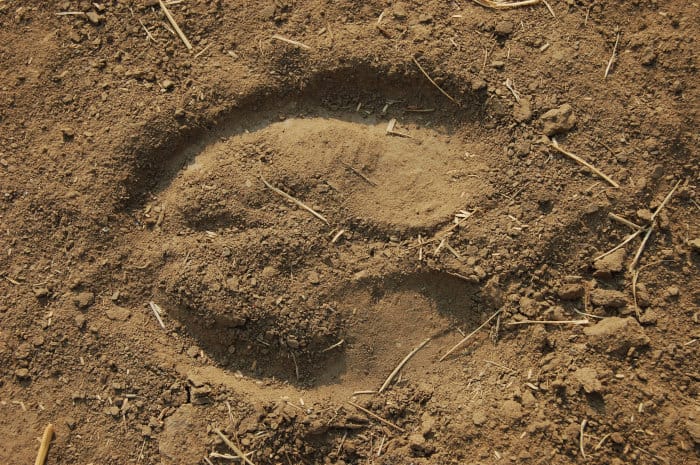
The Cape buffalo earned its place on the Big Five list as it was considered one of the most dangerous species to hunt.
Since its tracks are similar to several other ungulate species, one may need more time to identify buffalo spoor positively.
Signs of the wild that let you know that buffalo have been through include:
- Tracks measuring 13-14 cm (5.1-5″). They have hard cloven hooves that produce prints that closely resemble domestic cow tracks.
- Dung piles that look like large cow plops. The sizeable volume of the scat, its dark colour, and looseness, are unmistakable.
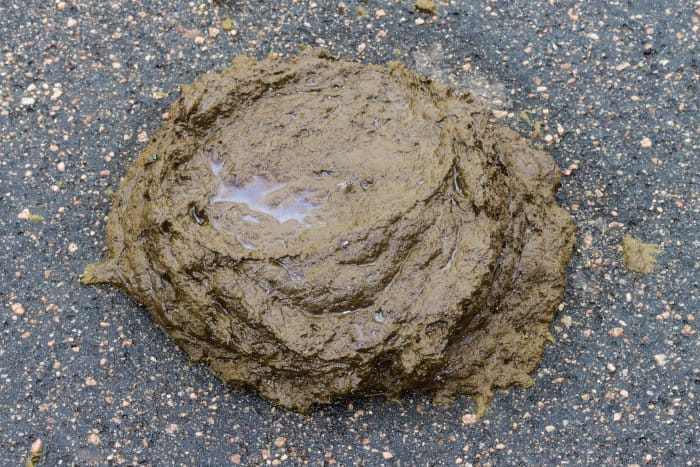
- Two dewclaw impressions may be evident on the back of each hoof impression if you are tracking in soft ground or mud.
- A lot of tracks and plenty of dung. Buffalo often move in large herds. Bulls may be solitary or in small groups.
- Listen carefully for grunting sounds made by buffalo.
More Signs of the Wild to Look Out for While on Safari
Of course, there is much more to African wildlife than just the Big 5! Some of Earth’s most unusual and delightful species roam free on the vast African continent.
While not all the creatures in Africa are easy on the eye, the beauty of experiencing a safari adventure is having your own personalized list of ‘must-see’ wildlife.
Improve your chances of spotting animals you may have only seen in zoos or animated movies by knowing what signs of the wild to look out for.
1. Hyenas have different sized paws
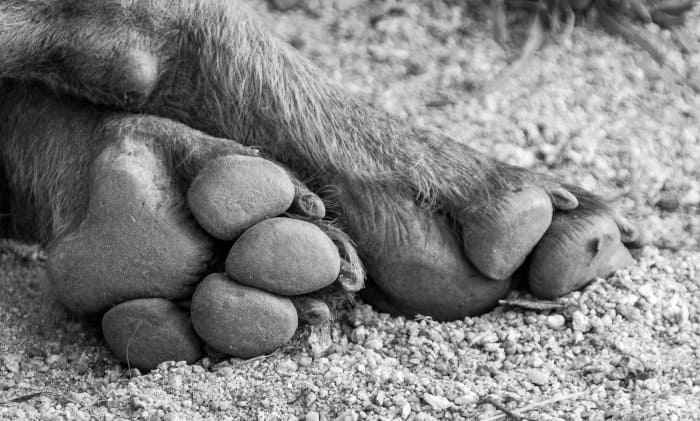
Although there are three distinct hyena species, the best known and largest is also the most stereotypical. Spotted hyenas are also called ‘laughing hyenas’ because of their distinctive vocalizations.
Hyena tracks can be identified using the following clues:
- Paw prints of around 11 cm (4.3″) in length. Hyena front paw tracks are bigger than their back paws.
- The main foot pads only have two lobes. This is distinct from any cat species, which always have three.

- Claw impressions that are visible on all the tracks.
- White droppings. Since hyenas’ diet includes the bones and teeth of other animals, their feces is usually white due to the high calcium component.
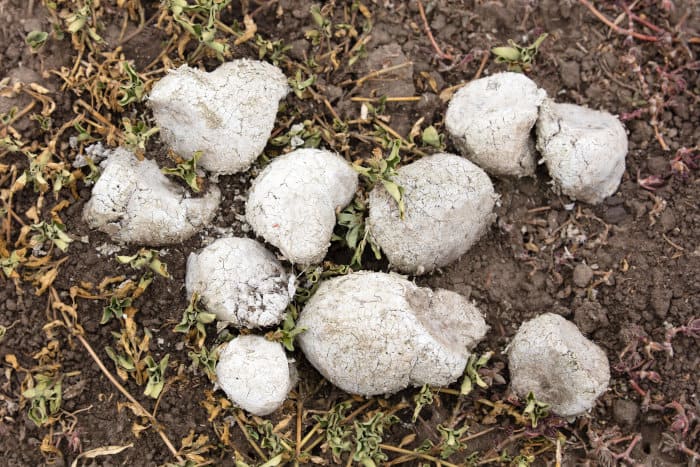
2. Hippopotamus tracks should be avoided
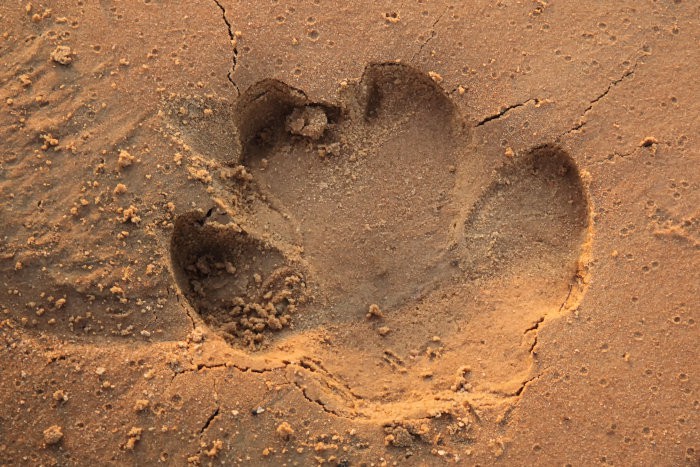
Don’t be fooled by their rotund pig-like appearance. Hippos have a reputation for having no sense of humor and can easily outrun a human. They are regarded by many as one of Africa’s most dangerous animals.
While it can be thrilling to see wild hippos, adhering to strict safety guidelines while in hippo territory is essential. Tracking hippo spoor should only be done by professional guides.
Signs that you may be near to hippos are:
- Tracks that are 230-280 mm (9-11″). They are unique in appearance and easy to identify. Each flat foot has four rounded toes.
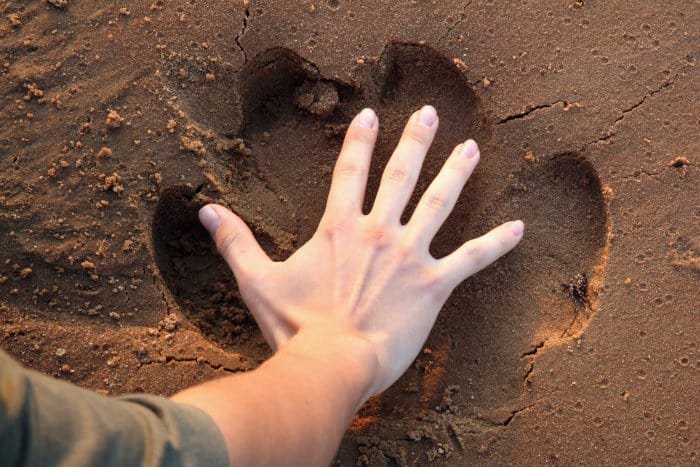
- Hippos are semi-aquatic, so they will only be found near rivers or lakes.
- Very short vegetation around a water source. It may appear mowed where the animals have been grazing.
- Listen for territorial sounds, which include loud vocalizations such as roars, honks, and groans.
3. Cheetahs use their claws for extra traction while running

Few things could be more thrilling than catching a glimpse of the fastest land animal. The lean-bodied cheetah is often camouflaged by tall grass and springs into action suddenly, with an incredible acceleration speed of 0 to 100 kph in 3 seconds! (0-62 mph)
Signs to be aware of that a cheetah may be in the vicinity include:
- Tracks are typically cat-like, with three distinct lobes on the main pad of each foot.
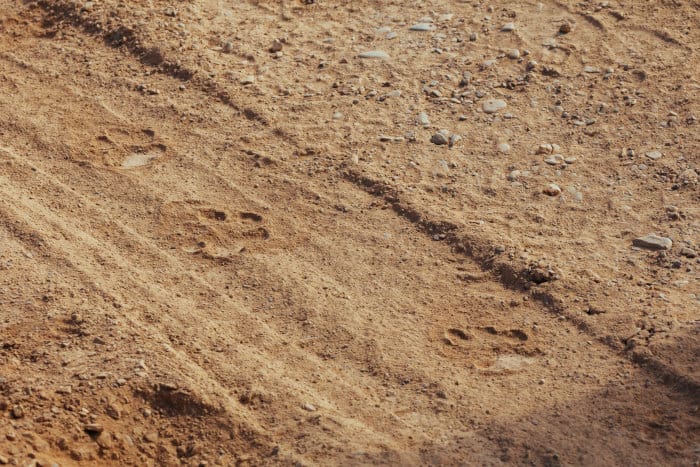
- Claw impressions may be visible on clear cheetah tracks. Cheetah tracks are unique because their claws are only semi-retractable.
Who Let the Dogs Out? Tracking Africa’s Canids
It may surprise many to learn that hyenas are far more closely related to the cat family than dogs — which can be confusing because they certainly don’t act anything like graceful felines!
Fortunately, despite this conundrum, Africa does boast a handful of true canine representatives you can look out for.
If you’re a dog lover hoping to catch a glimpse of an ancient ancestor of your daily walking companion while on safari, you will need to remain alert.
Unlike domestic dogs, Africa’s canines keep a low profile, and sightings are more often the result of lucky chance encounters than diligently following spoor.
Two of the best-known African dogs are jackals and wild dogs.
Let’s unpack some animal tracks and signs you should look out for if you are hoping to spot these elusive mammals.
1. Jackals will keep you awake at night

While they may be a rare sight on game drives, come nightfall, it is easy to tell when you are in jackal territory.
The high-pitched haunting calls that can be described as something between wailing, yelping, and howling, will leave you in no doubt that you are in wild Africa. There is nothing else quite like it!
In Botswana, the distinctive evening cry of the jackal is often called the ‘Cry of the Kalahari’.
Jackals use their loud nocturnal calls to communicate with each other, but it is also a sure sign for game viewers to know that they are nearby.
Once you have heard jackals, the next step is finding them. Although they are elusive, there are some signs to look out for:
- Tracks that are 5 cm long (1.9″).
- Paw prints that resemble small dog tracks.

- Tracks may be from a solitary animal or a bonded pair.
- Carrion attracts jackals. Be on high alert at kills made by other predators. Jackals are daring creatures that may even try to nip morsels off fresh lion kills.
2. African wild dogs are also called Cape hunting dogs
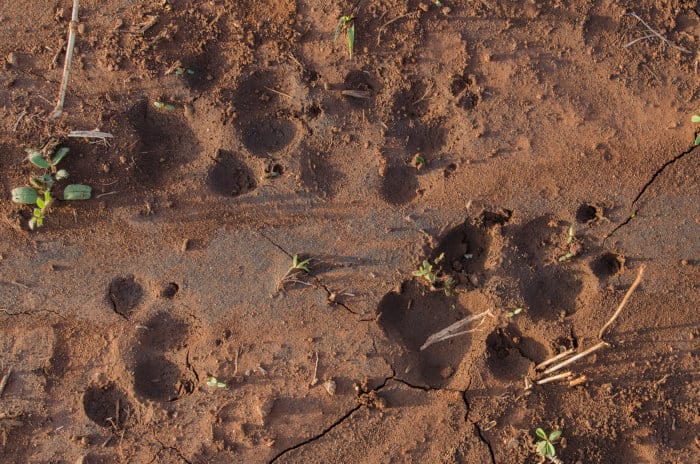
Classified as critically endangered, sighting a pack of African wild dogs on the African plains is a rare and memorable experience.
Although they were once widespread, habitat loss, conflict with humans, and infectious diseases have decimated their numbers.
Fortunately, African wild dogs with their distinctive mottled coats can still be found in a few Southern African countries.

Given their endangered classification and recent conservation efforts, coupled with the fact that packs can travel over 50 km (31 miles) each day, in some areas, a few individuals have been fitted with tracking collars.
Packs that stray out of safe areas can be quickly located and guided back to reserves.
If you are exploring the open plains of South Africa, Zambia, or Namibia, look out for the following signs that a pack of painted dogs is near:
- Paw prints that resemble domestic dog tracks. Two lobes on the main pad of each foot.
- Multiple prints in one area — African wild dogs live in packs averaging seven to fifteen members.
- Four toe impressions that always show nails.
- Spacing between pawprints of two feet is always close together, with a space before the following two closely placed impressions. Hyenas, which have similar feet, leave more evenly spaced prints in soft sand.
How to Recognize Some Common Ungulate Tracks
Ungulates are common on African plains and frequently found in large groups. Since they are high on the menu for prey animals, the grazers are often a skittish lot, so a good pair of binoculars is essential for any safari.
Grazers make up the greatest population of Africa’s mammals, and learning to identify individual species’ tracks correctly takes practice.
However, there are a few common ungulates with distinctive spoor that you should look out for.
1. Zebras live in herds to protect each other from predators

In many ways, zebra tracks resemble narrow horse tracks.
Although they are an entirely different species to horses, there are relations, and their hoof impressions can be difficult to tell apart from donkeys and horses in areas where they share territory.
What to look out for when on the hunt for zebra spoor:
- Dung and tracks from multiple animals. Zebras are sociable animals that live in herds.
- Numerous piles of kidney-shaped droppings.
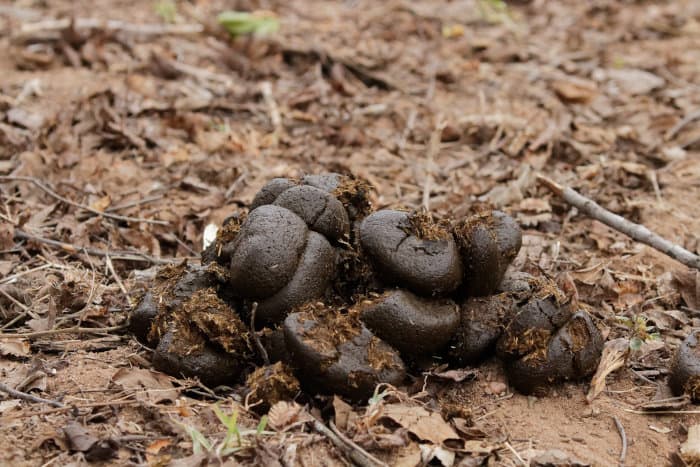
- Tracks that resemble the shape of small horseshoes. Zebras are single-hoof grazers.
2. Warthogs often shuffle along on their knees

Warthogs are among the most easily recognizable and comical creatures that grace the African plains.
Made famous by the iconic character in The Lion King, visitors often instantly call out ‘Pumbaa’ even when sighting one in the wild.
If you think you may have found warthog spoor, these are some things to check to confirm your suspicions:
- Tiny tracks that are only around 5 cm (1.9″). They have cloven hooves.
- The presence of dewclaws may be visible on the heel of each foot if tracking in soft, muddy ground.
- Hoof tracks that may be obscured in some spots. Warthogs have padded knees and readily drop onto their front knees while browsing to make it easier to reach short grass.

- Look for disturbed ground, especially around mud wallows.
- Multiple tracks may be evident since warthogs live in small family groups.
- Common warthogs live near a water source.
- Pellet-like scat may be evident.
3. Impala are called the McDonald’s of the African bush

It is unlikely that visitors on safari would miss seeing impala while out on game drives. Herds of these agile creatures are a common sight throughout Africa.
Impala are popular prey for many predators in Africa. The distinctive dark lines on either side of their bottoms and one in the middle of their tail look like the letter ‘M’ as they speed away.
This has given rise to many locals referring to them as McDonald’s fast food of the bush.
If you have found animal tracks and think that they may be from impala, check for the following signs:
- Cloven hoof impressions that appear in large numbers.
- Tracks that are very neat, pointed, and between 4-6 cm (1.5-2.3″).

- In breeding season, listen for the hoarse grunting sounds made by males.
- Huge gaps of up to 9 meters (29.5 ft) between hoof prints in some places. Impala can jump impressive distances, even from a standstill.
- Evidence of pellet-like dung, which is pointed on one end and concave at the other.
4. Wildebeest means wild beast in Dutch

Wildebeest, also known as gnu, are among the African landscape’s most peculiar-looking large antelope.
Their prominent bovine heads, horse manes and tails, spindly legs, and goat-like beards give them the appearance of a child’s drawing that has come to life.
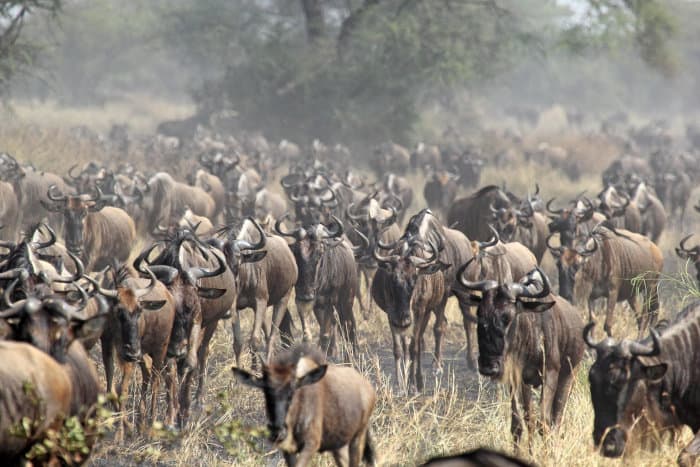
The great wildebeest migration of around 1.5 million animals in the Serengeti National Park is a famous natural phenomenon of blue wildebeest. There is also a smaller black wildebeest species that is found primarily in the grasslands of South Africa.
Look out for the following spoor when tracking these unusual-looking animals:
- Multiple cloven hoof tracks — Wildebeest always move around in large groups.
- Track shape that is rounded at the back and tapers sharply towards the front.
- Front hooves are larger than the back hooves. The front hooves of black wildebeest measure 9 x 6 cm (3.5 x 2.3″) and the hind hooves are 8 x 5.5 cm (3.1 x 2.1″).
- Listen for loud vocalizations. Wildebeest are a noisy lot, and bulls, in particular, are usually heard long before they are sighted.
5. Giraffes have surprisingly big feet

We end our expedition exploring some signs of the wild with one of the most iconic creatures in Africa.
No safari experience would be complete without sighting the lanky silhouettes of a herd of giraffes set against the rich red African sunset.
Since they are the tallest animals in the world, giraffe spoor is one of the easiest to identify.
Look out for the following signs that will let you know that giraffes are in the vicinity:
- Tracks that are up to 30 cm (11.8″) in length. They have very long, elongated cloven hooves.

- Droppings are larger than most other ungulates. They are often scattered about because they fall from a great height.

- Trees that have signs of browsing high up.
- Look out for giraffe food sources. Favorite trees include acacia, mimosa, and wild apricot, so be vigilant for signs of these gentle giants of the African plains in areas where these trees are common.
It’s Time to Put Your Tracking Knowledge Into Practice!
Experience the thrill of deciphering animal tracks in Africa for yourself by booking an unforgettable safari adventure. There are plenty of magical, affordable destinations to choose from!
Grab a copy of ‘Signs of the Wild’ field guide by Clive Walker and learn even more about animal tracks on your flight over. By the time you reach your destination, you will feel like an expert and be ready to track African animals like a pro!
Unlock the secrets of African wildlife with the click of your mouse! Whether you are a nature lover or dream of being a professional guide, learn to interpret animal tracks by signing up for one of the best safari training guide courses.
Leap into the adventure of a lifetime — we can’t wait to make it happen!
